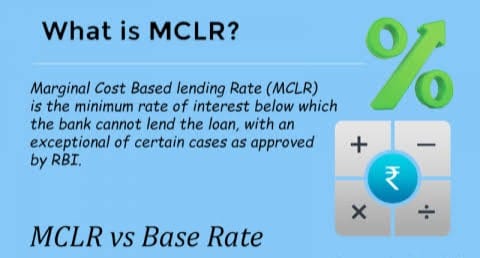LoanBaazar is excel in offering Home Loan, Mortgage Loan, Business Loan, Personal Loan, Education Loan, Credit Cards, SME Working Capital Loan and Equipment Finance at the most competitive rates from all leading Banks and NBFCs.

Introduction:
In the banking sector, interest rates play a crucial role in determining the cost of borrowing for customers. Over the years, different methods have been employed to calculate interest rates, with two prominent systems being the Marginal Cost of Funds Based Lending Rate (MCLR) and the Base Rate. This article aims to provide a comprehensive understanding of these two methods, highlighting their features, differences, and implications for borrowers.
What is MCLR?
The Marginal Cost of Funds Based Lending Rate (MCLR) is a benchmark rate introduced by the Reserve Bank of India (RBI) in April 2016 to ensure better transmission of policy rates to borrowers. Under the MCLR system, banks determine their lending rates based on their incremental cost of funds and tenor premium.
The MCLR framework takes into account various factors, including the repo rate, the cost of deposits, operating costs, and the desired net interest margin. This calculation enables banks to adjust lending rates promptly, reflecting changes in the cost of funds.
Understanding Base Rate:
The Base Rate is an interest rate system that was prevalent in India before the introduction of MCLR. It served as the minimum lending rate below which banks could not lend, although they were allowed to charge a rate higher than the base rate to account for their operational expenses.
The Base Rate was set based on factors such as the cost of funds, operational costs, and minimum rate of return. However, critics argued that the Base Rate was less transparent and lacked proper transmission of policy rate changes, leading to slower adjustment of lending rates.
Key Differences between MCLR and Base Rate:
| MCLR | Base Rate |
| Calculation Methodology The MCLR is determined based on the bank’s marginal cost of funds, which takes into account the cost of various types of deposits, operating costs, and other factors. Banks add a tenor premium to the MCLR, resulting in a final lending rate. | The Base Rate is calculated based on the average cost of funds for banks, including the cost of deposits and operational expenses. Banks have the flexibility to charge a rate above the base rate to cover their costs and earn profits. |
| Frequency of Rate Adjustment MCLR: The MCLR lending rates are typically revised at specific intervals, often monthly, quarterly, or annually. This ensures that changes in the cost of funds are quickly passed on to borrowers. | Base Rate: The Base Rate was revised periodically, but the frequency was not as consistent as the MCLR. As a result, the transmission of policy rate changes was slower and less efficient. |
| Transmission of Policy Rates: MCLR: The MCLR system aims to ensure better transmission of policy rates to borrowers. When the RBI changes the repo rate, banks are expected to adjust their MCLR and lending rates accordingly, providing more immediate benefits to customers. | Base Rate: The transmission of policy rates through the Base Rate system was considered inadequate. Banks had the discretion to adjust lending rates above the base rate, leading to delays in reflecting policy rate changes in loan interest rates. |
| Pricing for Existing Borrowers: The MCLR system allows banks to reset lending rates for existing borrowers periodically. However, this adjustment may involve administrative charges or fees, depending on the terms and conditions of the loan agreement. | Base Rate: Under the Base Rate system, existing borrowers often faced challenges in benefiting from lower interest rates due to slower rate adjustments. Banks had the discretion to apply changes to new loans while maintaining higher rates for existing borrowers. |
Implications for Borrowers:
a) Transparency and Faster Transmission: MCLR brings greater transparency to interest rate determination as it considers multiple factors, leading to a more objective calculation. Additionally, the frequent revision of MCLR rates ensures a faster transmission of policy rate changes, allowing borrowers to benefit from reduced interest costs sooner.
b) Benefit for New Borrowers: New borrowers can take advantage of the MCLR system as their interest rates will be based on the prevailing MCLR rate. This provides an opportunity to access loans at rates that are more in line with the current cost of funds.
c) Challenges for Existing Borrowers: Existing borrowers under the Base Rate system may face difficulties in availing the benefits of reduced interest rates. The transition from Base Rate to MCLR may involve additional administrative charges or fees, making it less favourable for some borrowers.
Conclusion:
The transition from the Base Rate system to the MCLR system marked a significant step toward improving the transmission of policy rates and ensuring a fairer lending rate mechanism in the banking sector. The MCLR system, with its transparent calculation methodology and frequent rate adjustments, aims to benefit borrowers by providing better access to affordable loans. However, challenges remain for existing borrowers who may face additional costs during the transition. It is important for borrowers to understand the implications of both systems and assess their options before making financial decisions.